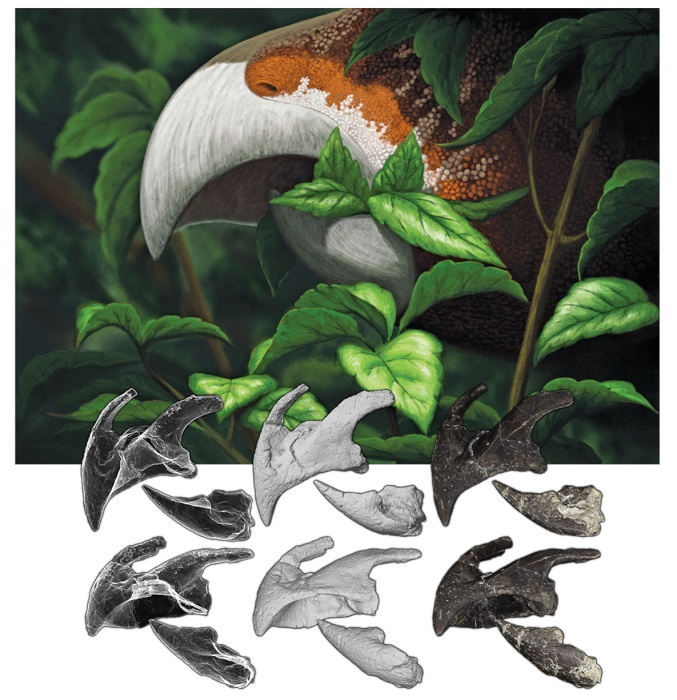
It was considered the strongest evidence for the presence of ceratopsians (horned dinosaurs) outside Asia and North America. The discovery was even described in Nature. Scientists from the Polish Academy of Sciences, however, question this in their research, showing that the fossils belonged to a completely different group of dinosaurs.
The dinosaur in question is Ajkaceratops kozmai from the Late Cretaceous (approximately 85 million years ago); its remains (fragment of the snout) were found in Hungary. In 2010, a team led by Hungarian paleaontologist Attila Ősi described it as a horned dinosaur, and the paper appeared in Nature. So far, it was considered the strongest evidence for the presence of ceratopsians outside Asia and North America, where they were common.
Dr. Łukasz Czepiński and Dr. Daniel Madzia from the Institute of Paleobiology of the Polish Academy of Sciences re-examined the material and showed that the postulated similarities to the ceratopsian group were mainly superficial.
'Ajkaceratops has been interpreted as a horned dinosaur similar to the Asian Bagaceratops. However, it has a strange anatomy. Its snout may indeed resemble the snouts of some ceratopsians, but upon closer analysis, doubts arise', Dr. Czepiński tells PAP - Science in Poland.
He explains that the snouts of ceratopsians are characterized by the presence of a specific rostral bone, which does not occur in any other group of animals. 'Its presence was also suggested in Ajkaceratops, which was supposed to be evidence that it was a horned dinosaur', he points out.

'And indeed, at first glance there are these similarities, and at the front of the Ajkaceratops snout there is a horn-covered structure that resembles the rostral bone of horned dinosaurs. However, a closer look at this part reveals that it differs significantly from all ceratopsians known to science. It is possible that it is actually an unusually overgrown premaxilla, which led us to hypothesise that it may be another herbivorous ornithischian dinosaur with uncertain affinities', says Czepiński.
Another clue, the scientist continues, is that despite finding hundreds of thousands of fossils at the Iharkút site, where Ajkaceratops comes from, so far not a single tooth unquestionably belonging to a horned dinosaur has been discovered. And teeth, thanks to their frequent replacement in reptiles, are usually the most common evidence of the presence of a given group of dinosaurs in a specific place.
Additionally, 3D models of the entire snout, developed on the basis of preserved parts, showed that when its mouth was closed, Ajkaceratops must have had the beak of the upper jaw extended significantly forward, which was another surprise for researchers from the Polish Academy of Sciences, as it would indicate an unusual anatomy and biology of this dinosaur.
Czepiński adds that there were many endemic (i.e. found only in a given area) groups of herbivorous dinosaurs in Europe. 'Many of them are still unknown because we only find fragmentary remains. Perhaps this is one of the representatives of such a group', he says.
The topic of re-examination of Ajkaceratops material emerged during other research by Czepiński, when he was dealing with Asian species which Ajkaceratops, according to the earlier publication in Nature, was supposed to resemble.
Ceratopsians (horned dinosaurs) are a group of herbivorous dinosaurs, the most famous representative of which is Triceratops. At the culmination of their evolutionary history, in the Late Cretaceous (approximately 85-66 million years ago), they were among the most dominant land animals in North America and Asia.
'Remains outside these continents are rare and their interpretation is usually uncertain. Currently, the most solid evidence for the presence of this group in Europe is an incomplete skeleton from Germany and teeth found in Sweden. The track from the Polish Roztocze may also belong to ceratopsians, but we still have to wait for more complete finds',
Czepiński says.
Find out more in the publication in the Zoological Journal of the Linnean Society, published by Oxford University Press.
PAP - Science in Poland, Agnieszka Kliks-Pudlik
akp/ bar/ kap/
tr. RL













